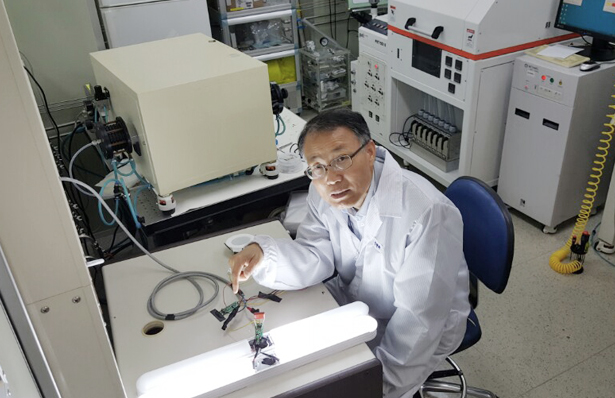
MIT Switching Technology
to Shift Lighting Paradigm
A group of researchers in Korea have successfully developed a smaller and more efficient control board by using an innovative device to convert the existing fluorescent lights to LED lamps. This is a paradigm-shifting achievement for the lighting markets with significantly lowered unit cost for producing boards.
On June 21, ETRI announced that it used the switching technology, identified in 2005 through MIT (metal-insulator transition), and developed a much simplified LED control board with higher luminous efficiency than the common industrial counterpart compatible for fluorescent lights.
In particular, by using the MIT devices, this new technology can increase luminous efficiency for 14% or more than the existing commercial products. Whereas the current commercial control boards are 30 centimeters long and require about 50 different components including a transistor, the test control board using the MIT technology is only three centimeters long and operates with only eight different components including an MIT transistor. Consequently, the technology will be able to be used in creating tiny globular shapes or other possibilities for LED lamps. Since the control boards for LED lamps have begun to develop and distribute as an all-in-one type, ETRI’s new technology is expected to pave a foundation for distributing LED lamps with more efficient and smaller control boards at a lower price.

The core technology applied to the control board was MIT transistor (with a NDR switching) technology to allow high-speed switching at 20 KHz-60 KHz. The researchers explained that they created a single chip by combining a silicon-based device and a device made with the MIT material such as vanadium dioxide developed by Dr. Hyun-Tak Kim. ETRI believes that the development of LED lamps through MIT technology is significant as the follow-up research of the initial findings published in 2013 regarding the principle of the MIT phenomenon in silicon semiconductor devices and as the creation of applied products for commercialization.
Regarding to this technology, the ETRI researchers applied for two core patents: constant-current circuit technology and NDR MIT technology as negative differential resistance. The latter involves decreasing voltage due to lowered resistance when the MIT phenomenon occurs at a constant current. Applications for patent registration for this technology were made in five countries, and registration has been completed in the United States and Japan.
Dr. Hyun-Tak Kim applied the MIT technology to fire detectors and developed an electronic switch and circuit breaker in 2015 and is currently working on their commercialization. Whereas these achievements were based on the constant MIT phenomenon, the latest technology taps into the high-speed switching performance of MIT. Moreover, last April, Dr. Kim successfully developed a technology to manufacture eight-inch wafers for mass-production of the MIT devices. “MIT’s fast switching technology is advantageous for making highly efficient and compact devices,” explained Dr. Kim. “We will continue to apply the technology to lighting and spread it across the world.”



In cooperation with Mobrik, a manufacturer of the MIT devices, ETRI presented the MIT devices and applied technologies at the International LED and OLED Expo 2016, held in Ilsan in June. This first-time disclosure to the public won heated interest and a favorable response from those in the related industries. Commercialization of this technology is scheduled within this year after undergoing quality accreditation.
The global market value for switching devices, including switching stabilizers used for this research, and switching systems is expected to reach more than USD 200 billion by 2020, and that for LED lighting will amount to USD 85 billion. The researchers at ETRI are now set to bolster marketing efforts through technology transfer to related businesses. The paper of Dr. Hyun-Tak Kim has been cited over 4,600 times globally. Since 2002, 85 papers have been published in relation with MIT, and 74 domestic and 193 international patents have been registered.
